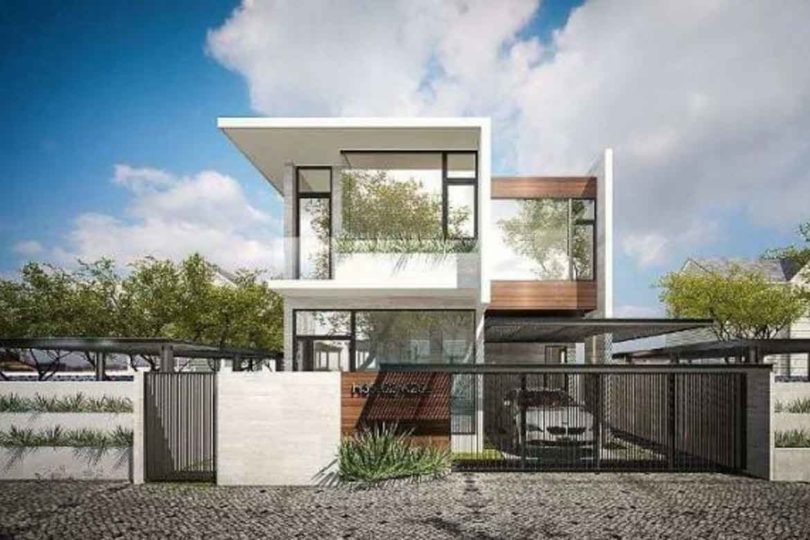What is Minimalist House Design?

Minimalist house design is a design movement that originated in the 20th century. It’s characterized by the use of simple forms, clean lines, and a limited color palette. The goal of minimalist design is to create a sense of calmness and serenity by eliminating clutter and unnecessary elements. This design style is not just limited to aesthetics; it’s also about creating a functional and efficient living space.
Principles of Minimalist House Design
There are several principles that guide minimalist house design. These include:
- Simplicity: Minimalist design is all about simplicity. It’s about eliminating clutter and unnecessary elements to create a sense of calmness and serenity.
- Clean Lines: Clean lines and minimal ornamentation are hallmarks of minimalist design. This creates a sense of openness and airflow.
- Limited Color Palette: A limited color palette is used in minimalist design to create a sense of cohesion and calmness. Neutral colors such as white, gray, and beige are commonly used.
- Functional: Minimalist design is not just about aesthetics; it’s also about creating a functional and efficient living space.
- Sustainability: Minimalist design often incorporates sustainable materials and energy-efficient systems to reduce waste and minimize environmental impact.
Benefits of Minimalist House Design
There are several benefits to incorporating minimalist house design into your living space. These include:
- Reduced Clutter: Minimalist design helps to eliminate clutter and create a sense of calmness and serenity.
- Improved Focus: A minimalist living space can help improve focus and productivity by reducing distractions.
- Increased Efficiency: Minimalist design can help create a more efficient living space by eliminating unnecessary elements and streamlining processes.
- Cost-Effective: Minimalist design can be cost-effective as it often incorporates sustainable materials and energy-efficient systems.
- Timeless: Minimalist design is timeless and never goes out of style, making it a great investment for your living space.
Tips for Incorporating Minimalist House Design into Your Living Space
If you’re interested in incorporating minimalist house design into your living space, here are some tips to get you started:
- Start with a Clean Slate: Begin by clearing out your living space and getting rid of any unnecessary items.
- Use a Limited Color Palette: Choose a limited color palette to create a sense of cohesion and calmness.
- Incorporate Natural Light: Natural light can help create a sense of openness and airflow.
- Use Multi-Functional Furniture: Multi-functional furniture can help create a more efficient living space.
- Add Plants: Plants can help purify the air and create a sense of calmness.
Common Mistakes to Avoid
When incorporating minimalist house design into your living space, there are several common mistakes to avoid. These include:
- Over-Accessorsizing: Avoid over-accessorizing your living space with too many decorative items.
- Using Too Many Colors: Using too many colors can create a sense of clutter and chaos.
- Not Considering Functionality: Not considering functionality can lead to a living space that is not efficient or effective.
- Not Incorporating Storage: Not incorporating storage can lead to clutter and disorganization.
FAQs
Q: What is the main principle of minimalist house design?
A: The main principle of minimalist house design is simplicity.
Q: What are the benefits of incorporating minimalist house design into my living space?
A: The benefits of incorporating minimalist house design into your living space include reduced clutter, improved focus, increased efficiency, cost-effectiveness, and timelessness.
Q: How can I incorporate natural light into my living space?
A: You can incorporate natural light into your living space by using sheer curtains, skylights, or larger windows.
Q: What type of furniture is best for a minimalist living space?
A: Multi-functional furniture is best for a minimalist living space as it helps create a more efficient and effective living space.
Q: How can I avoid over-accessorizing my living space?
A: You can avoid over-accessorizing your living space by using a limited number of decorative items and choosing items that are functional and meaningful.
Conclusion
In conclusion, minimalist house design is a great way to create a peaceful and functional living space that promotes focus, productivity, and relaxation. By incorporating the principles of simplicity, clean lines, limited color palette, functionality, and sustainability, you can create a living space that is not only aesthetically pleasing but also efficient and effective. Remember to avoid common mistakes such as over-accessorizing, using too many colors, and not considering functionality. With these tips and principles in mind, you can create a minimalist living space that is perfect for your needs and lifestyle. Whether you’re a student or not, minimalist house design is a great way to create a living space that is calm, serene, and functional. So why not give it a try and see the benefits for yourself?
Closure
Thus, we hope this article has provided valuable insights into Minimalist house design for students. We hope you find this article informative and beneficial. See you in our next article!